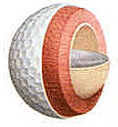An object with a low coefficient of restitution will lose a great deal of its kinetic energy in a collision through
breaking or deforming, or through the generation of sound or heat. Compare the kinetic energy transmission through
steel balls suspended on strings as they bounce back and forth in an example of a high coefficient of restitution.
Now consider a lump of clay or a piece of glass in a collision, both materials having very low restitutional values -
they simply do not transfer energy well because they are not as elastic.
How does all of this tie back into the temperature of materials? Temperature can also affect elasticity - the colder a
material gets, the less elastic it can be. Under cold conditions, the material can actually become more of an 'energy
sink' - absorbing energy rather than transferring it.
Solid core balls rely on the principle of coefficient of restitution. A ball that is warm has more elasticity than an
identical ball that is cold.
Weak Rebound = Low Velocity
Q:
Not all golf balls are constructed the same. Does the quality of the ball matter?
A:
The most popular premium balls on the market today are three-layered or even four different layers. Each layer is
designed to provide some distinct characteristic to the ball's performance. Most multi-layered balls have their cover as
one layer. Inside of that, they consist of two, separate one-piece layers. The internal layer, the core, is a small,
synthetic, rubbery ball.
 Some, balls have a hollow core filled with a liquid material optimized to produce feel and
resiliency. If the core, or any of the layers, is colder that the outside course temperature, or if the ball and course
are below 80� C, the layers and the core will not compress adequately. It is this inadequate compression that affects
flight trajectory, speed off the clubface (distance) and accuracy.
Some, balls have a hollow core filled with a liquid material optimized to produce feel and
resiliency. If the core, or any of the layers, is colder that the outside course temperature, or if the ball and course
are below 80� C, the layers and the core will not compress adequately. It is this inadequate compression that affects
flight trajectory, speed off the clubface (distance) and accuracy.
Essentially, what matters is warming the inside of the ball.





